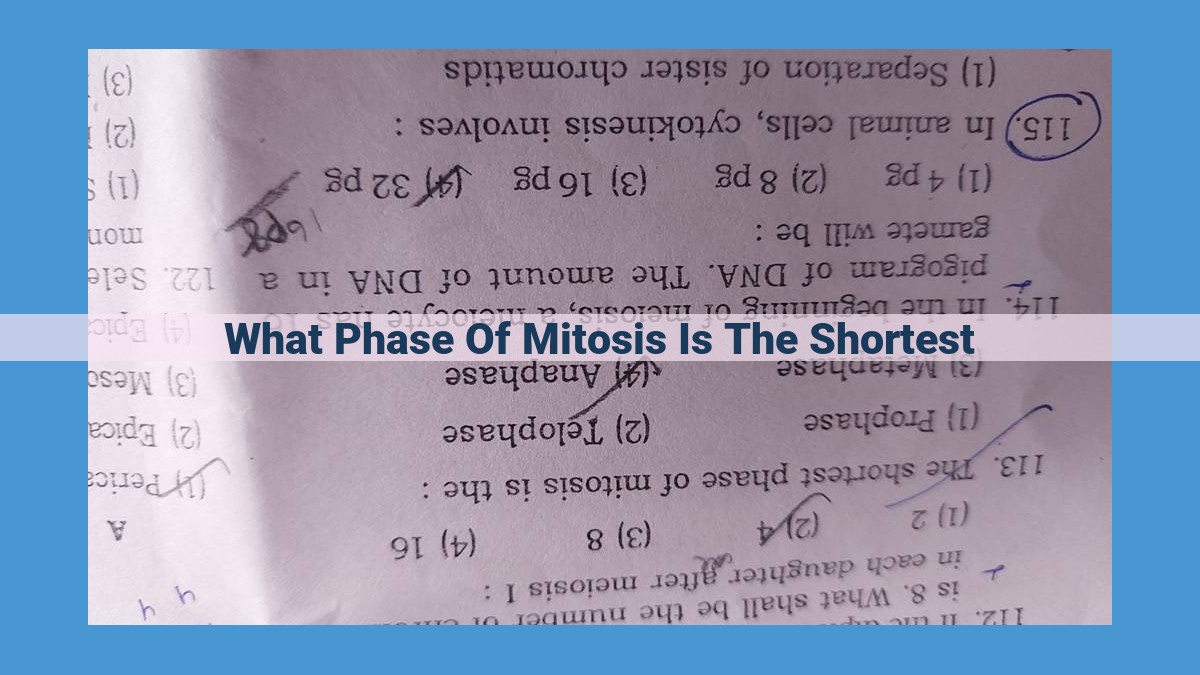Metaphase, the shortest phase of mitosis, plays a crucial role in ensuring the accurate segregation of chromosomes during cell division. During Metaphase, the chromosomes align along the equatorial plane of the cell, with spindle fibers attached to their centromeres. This alignment ensures that each daughter cell receives an equal complement of genetic material. Despite its brevity, Metaphase is a critical phase, as errors in chromosome alignment can lead to genetic abnormalities and potential health issues.
- Overview of the process of mitosis
- Explanation of its importance for cell division
Mitosis: The Dance of Cell Division
In the intricate world of cells, a meticulously orchestrated process called mitosis takes place, ensuring the faithful duplication and distribution of genetic material. This cellular ballet is crucial for growth, development, and the repair of tissues in our bodies.
Mitosis is a continuous process, but for simplicity, scientists divide it into four distinct phases: prophase, prometaphase, metaphase, and anaphase. During prophase, the chromatin within the nucleus condenses into visible chromosomes, each consisting of two sister chromatids joined at a central point called the centromere. Additionally, the nuclear envelope disintegrates, and spindle fibers, composed of microtubules, begin to form.
As the cell progresses to prometaphase, the spindle fibers extend from opposite poles of the cell and attach to the centromeres of the chromosomes. This attachment is key for ensuring the orderly segregation of chromosomes during later stages of mitosis.
Phases of Mitosis: A Journey of Cell Division
Mitosis, a fundamental process in cell biology, ensures the accurate replication and distribution of genetic material during cell division. This complex dance of cellular machinery unfolds in a series of distinct phases, each with its own unique choreography.
Prophase: The Curtain Rises
Prophase marks the beginning of mitosis, characterized by a flurry of activity within the cell. Chromatin, the tightly packaged DNA, condenses into visible chromosomes. The nuclear envelope, the cell’s protective boundary, begins to disassemble. As centrosomes, responsible for organizing the spindle fibers, move to opposite poles of the cell, the spindle apparatus emerges.
Prometaphase: Chromosomes Take Center Stage
Prometaphase witnesses the migration of chromosomes to the center of the cell. Spindle fibers, the guiding force of mitosis, attach to the centromeres, the pinching point of chromosomes. This attachment ensures the equal distribution of genetic material to daughter cells.
Metaphase: A Precise Orchestration
Metaphase is the briefest yet crucial stage of mitosis. The aligned chromosomes form a straight line at the cell’s equator. The spindle fibers, acting like taut ropes, apply tension to the chromosomes, ensuring their correct segregation.
Anaphase: The Pulling Away
Anaphase brings a rapid separation of chromosomes as the spindle fibers contract. The sister chromatids, identical copies of chromosomes, are pulled apart and move to opposite poles of the cell. This separation is essential for creating two genetically identical daughter cells.
Metaphase: The Pivotal Stage of Cell Division
In the intricate dance of cell division, Metaphase emerges as a critical choreography, orchestrating the precise alignment of genetic blueprints for the creation of new cells. This brief yet pivotal phase holds immense significance for the fate of dividing cells.
Metaphase owes its status as the shortest phase of mitosis to its straightforward yet crucial task. It prepares the stage for the final act of chromosome segregation, ensuring the equitable distribution of genetic material. This delicate balancing act requires the meticulous alignment of chromosomes along the equator of the cell, known as the metaphase plate.
At this pivotal moment, the spindle fibers, acting as the puppeteers of the cell, extend from opposite poles of the cell. These fibers attach to the kinetochores, specialized protein structures located at the center of each chromosome. With the chromosomes tethered to the spindle fibers, they resemble a graceful suspension bridge, suspended in anticipation of the momentous event that awaits.
Metaphase: The Critical Phase for Accurate Chromosome Segregation
In the grand symphony of cell division, Metaphase stands as a pivotal movement, orchestrating the precise alignment and distribution of genetic material. This fugue of cellular precision ensures that each newly created cell receives an exact copy of the mother cell’s genetic blueprint.
Metaphase’s significance lies in its meticulous choreography of chromosome movement. During this phase, the cell’s spindle fibers extend from opposite poles of the cell, resembling the strings of a cosmic puppet master. Each spindle fiber attaches itself to kinetochores, structures located on the centromeres of chromosomes, the X-shaped regions where the chromosome’s sister chromatids are joined.
As the spindle fibers pull on the kinetochores, the chromosomes line up precisely along the equator of the cell, each chromosome positioned with utmost exactitude. This delicate dance ensures that the genetic material is evenly distributed between the two daughter cells.
However, the importance of Metaphase extends far beyond its role in chromosome alignment. It is during this phase that errors can have dire consequences. If the spindle fibers fail to attach properly to the kinetochores, or if the chromosomes fail to align correctly, unequal segregation of chromosomes may occur.
Such aneuploidies, as they are called, can lead to a wide array of health problems, including cancer, birth defects, and mental disabilities. The cells may lack essential genetic material or possess extra copies of chromosomes, disrupting normal cellular function and leading to developmental abnormalities.
Therefore, the precision of Metaphase is not merely a matter of cellular tidiness; it is a fundamental safeguard for the integrity of our genetic code and the well-being of our cells. It is a testament to the incredible complexity and elegance of the cellular universe, where even the smallest biological events have profound implications for life itself.
